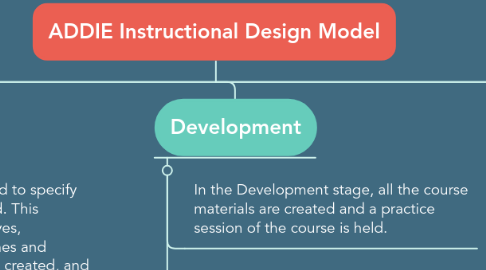
1. Analysis
1.1. In the Analysis stage,the specific need that the training will address is defined, the learner's knowledge gap is assessed, available resources are identified, and learning outcomes are identified. The feasibility of developing the training is determined.
1.2. Actions:
1.2.1. 1. Clearly identify the need by meeting with key stakeholders.
1.2.2. 2. Determine if training is the appropriate action to address the identified need.
1.2.3. 3. State the primary goal our outcome this training will accomplish.
1.2.4. 4. Identify the learner's current knowledge set and what information they need to bridge the gap from what they currently know to what they need to know.
1.2.5. 5. Define necessary resources to create and perform the training (i.e. venue, equipment, developers, instructors, SMEs). Ensure key stakeholders are invested both financially and by committing resources.
2. Design
2.1. In the Design stage, a plan is created to specify how the course will be implemented. This includes specifying learning objectives, assessments, content blocks, timelines and sequencing, training materials to be created, and other media that will be used or created for the training.
2.2. Actions:
2.2.1. 1. Write specific and measurable learning objectives.
2.2.2. 2. Write assessment questions and/or identify assessment exercises based on learning objectives.
2.2.3. 3. Identify any pre-requisites or skills attendees must have prior to attending the training.
2.2.4. 4. Define how the course will be delivered: instructor led, webinar, e-Learning, self-paced, etc.
2.2.5. 5. Create a training course agenda or timeline showing the overall length of the course and order of topics to be discussed.
2.2.6. 5. List all materials to be created. This may include pre-work materials, workbooks, presentation slides, videos, activities, knowledge checks, assessments, homework assignments, post-course/follow-up materials, and course evaluations.
3. Development
3.1. In the Development stage, all the course materials are created and a practice session of the course is held.
3.2. Actions:
3.2.1. 1. Storyboard the training activities and identify the format and/or media that will be used for each section (exercise, workbook, video, etc.)
3.2.2. 2. Hold Knowledge Transfer sessions with Subject Matter Experts (SMEs) to gather necessary information as it relates to course objectives.
3.2.3. 3. Create materials listed in the Design stage, i.e. workbook materials, student guides, instructor guides, block diagrams, job aids, videos, knowledge checks, and assessments ensuring that each relates to a learning objective created during the design phase. In addition to materials used during the course, consider pre-course and post-course materials and assessments.
3.2.4. 4. Hold a practice session of the course and gather feedback to make any necessary changes. Modify timelines, correct course materials, and implement feedback to make course more effective. Invite other instructors, SMEs, and stakeholders to attend.
3.2.5. 5. Submit all materials through applicable content review process for final review and revision control.
4. Implementation
4.1. In the Implementation stage, the actual course is delivered to the targeted learning group.
4.2. Actions:
4.2.1. 1. Use the course materials to deliver the training content.
4.2.2. 2. During the delivery of the course, make notes of any content that needs to be updated, corrected, or delivered at a different time or in a different way to be more effective.
4.2.3. 3. Ensure students are achieving the learning objectives and add clarity and guidance to support their learning.
4.2.4. 4. Note any informal feedback students provide while participating in the session.
5. Evaluation
5.1. In the Evaluation stage, the results and effectiveness of the training is assessed.
5.2. Actions:
5.2.1. 1. Review instructor notes taken during the course for course improvements and determine if and how to implement the recommended changes.
5.2.2. 2. Review course surveys and other feedback from participants and identify what improvements can be made to the course.
5.2.3. 3. Follow-up with participants after the course has been completed to see how they are using the material they learned in the training course.
5.2.4. 4. Review assessment scores to verify objectives are being met by the learners and that the assessment tools are effective. Recommend any changes to the assessment tools if they are not relevant or are misleading in any way.
